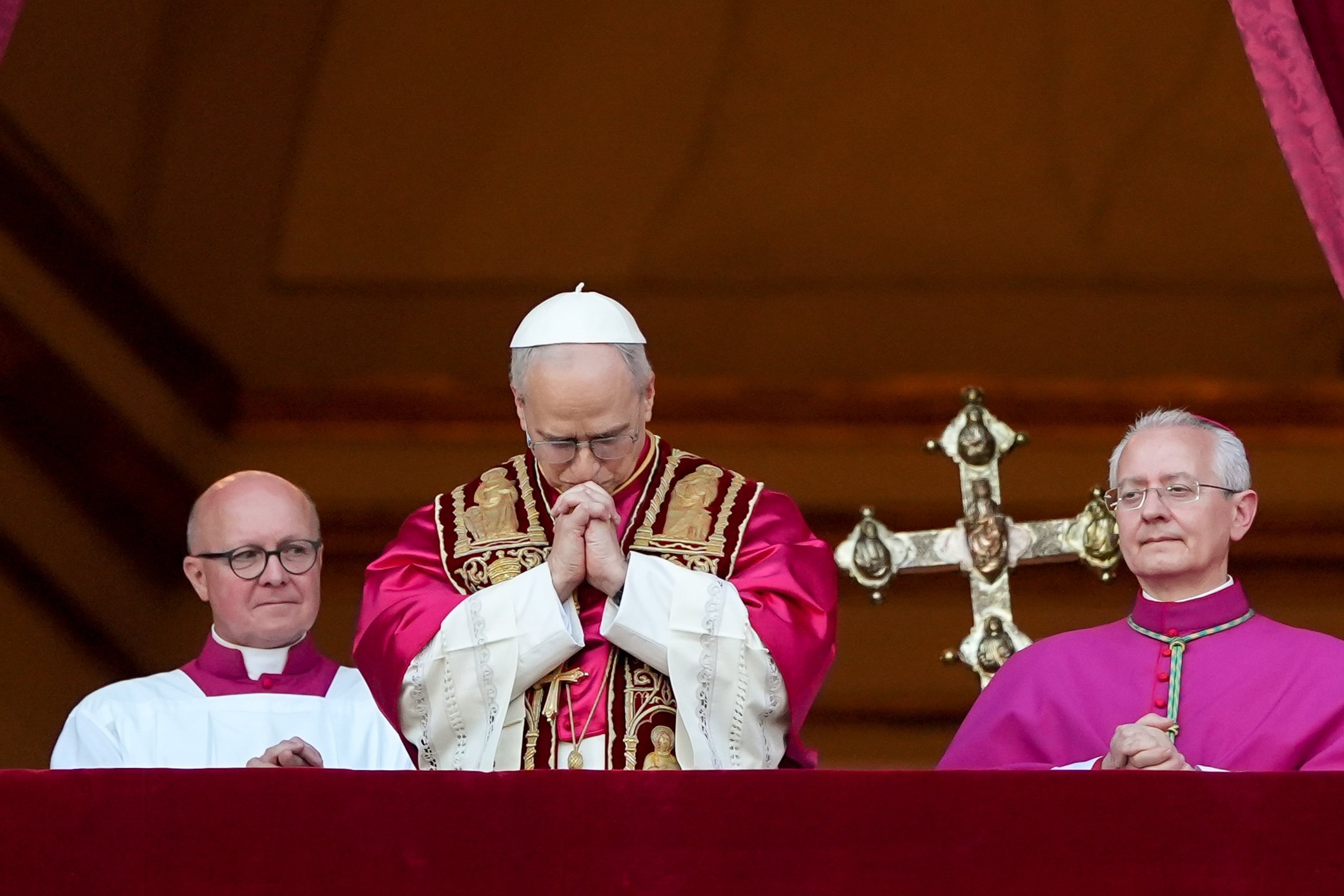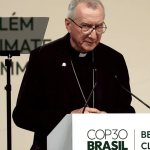I hesitate. From atop the colonnade, behind the statues, I can see the balcony as closely as possible — the balcony that holds the attention of the entire world. From there, the chimney is out of view.
I stay below, in the square. I bump into a familiar face. A Bob Marley jersey, a forests of flags, the scent of cigarillos, a camping-like atmosphere. Priests in collars, monsignors in cassocks, children sleeping in their parents’ laps, Franciscan friars in habits, nuns in blue scapulars. Excited murmurs ripple through the crowd. A bishop appears among the people. Phones rise in the air. I stand beside the colonnade, among tens of thousands. I can see both the distant chimney and, just three meters from me, the massive screen showing the main action up close.
We’re expecting it this afternoon. It’s going to happen today. It happened on the second day both previous times. That’s what’s in the air. Twice now, the smoke was black — each time a wave of disappointment surged through the square, hitting from every side. Yet it didn’t crush us; deep down we knew it would’ve been too soon.
For hours, I watch the chimney — sometimes directly, sometimes on the screen. When you’re waiting for something with all your soul, your eyes start to imagine it. Your senses play tricks. You see what you want to see. Then the illusion fades and you realize it was only hope, not smoke. One hour passes. Then another. I’m sweating under the sun. My eyes grow weary. Still we wait.
The seagulls are part of the scene. At night, their bellies painted gold by the decorative lighting, they dart through the air like shooting stars. Now, as if aware that the world is watching this copper pipe, they stroll lazily across the centuries-old rooftiles, watched by the crowd in St. Peter’s Square on the giant screens. One gull circles the chimney. Then another. Moments later, a fuzzy grey chick waddles into view. Laughter rolls across the square — a collective psychological release. All eyes turn to the screens. Phones snap to attention. One of the adult gulls — the father, perhaps — regurgitates food, which the chick pecks at beside the chimney. Paternal care. A burst of laughter and applause follows. “Like the Holy Trinity!” someone next to me exclaims. And indeed — the unity, the bond, the care — white birds, sunshine, a hopeful sign. What if the smoke comes now?
I stare harder — from screen to sky, screen to chimney. My gaze fixes. The three gulls flutter around the pipe. I look up. Now! Now! I whisper to myself. And in that instant, for a fraction of a second, my senses betray me. One of the gulls flaps away — and suddenly, a wisp of grayish smoke curls from the top of the chimney.
It’s white. I tell myself it’s white. The previous smoke was definitively black. This one grows denser, brighter, unmistakably white. White smoke! In the span of a second, my heart pounds, my eyes well up, voice catches — We have a pope!
A roar erupts. Cheers explode from the crowd. Seventy-five thousand people weep for joy. He is chosen. He is here. We don’t yet know his name, his face, his age, or even if he was my favourite, but he is ours. He is the one the whole world has waited for.
I keep my eyes on the screen. Then on the real chimney. The white smoke dances upward in the golden sunlight. Everything speeds up. My heart races. My eyes blur. Goosebumps rise up. My camera shakes in my hand. The exhaustion of the past three days vanishes in an instant. I try to describe the moment over the phone to those back home, but how can you transmit this heartbeat, this rush?
People are hugging, crying, dancing, jumping, clapping, shouting. “Last time I felt this was at a Rolling Stones concert!” someone yells.
I dash toward the spiral staircase leading to the top of the colonnade. I’m breathless when I reach the roof — the Carlo Magno Terrace. Only from above do I truly see the immensity of the crowd, chanting, waving flags, swelling from every direction. The cafés along the Via della Conciliazione empty in seconds. Coffees, Aperol spritzes, and sandwiches are abandoned. Shopkeepers pull down shutters and run to the square. Everyone wants to be closer — not for a better view, but for the nearness itself. Closer to him, whoever he may be. The one the Holy Spirit has chosen.
My legs tremble. My head spins. I stand among the cameramen in the prime position, between the 3-meter-high statues of Sts. Primus and Felician.
A brass band strikes up a triumphant march. Uniformed guards take their places in front of the basilica. The new pope, we know, is now accepting the papal mandate, greeting his fellow cardinals, ressing in the “Room of Tears” — where surely he weeps with joy, humility, fear — praying in the Pauline Chapel. And then — he will appear.
Finally, the red curtain stirs. Applause and cheers erupt from the square to the Castel Sant’Angelo. Cardinal Dominique Mamberti, cardinal protodeacon, must wait — the ovation drowns out everything. Then, he begins the long-anticipated declaration, every syllable strained to be heard in a square notorious for poor acoustics:
“Annuntio vobis gaudium magnum!” The crowd interrupts with jubilant noise. “Habemus Papam!” The announcement unleashes the loudest ovation yet.
And then… the name: “Robertum Franciscum…”
I know instantly. My voice trembles, but I speak clearly to the stunned reporters around me: “Robert Francis Prevost. American!”
Cardinal Mamberti confirms it: “Cardinalem Prevost.”
Every tremble, every fear and uncertainty melts away. The carousel of doubt halts. I’m steady again. Surprised, but joyful. Now I know. Not this one, not that one — but him. Prevost. “Leonem decimum quartum.” Leo XIV.
To me, Pope Francis was the Pope. I couldn’t imagine anyone replacing him — his face, his voice, his actions. But in that moment, the feeling faded. Because now, Leo is pope. The American — who takes as his namesake Pope Leo XIII, the scholar, the bridge-builder, who addressed the world’s struggles and responded with clarity, the first to speak up for the poor, the exploited, the workers, the one who laid the foundation for Catholic social teaching.
Leo XIV is more South American than North American. As head of the Dicastery for Bishops, he knows the global Church. He was not among the most-often named, but perhaps we should not have obsessed over the names. We should have left it to the Holy Spirit. Because Christ’s vicar is now entrusted to someone unexpected, who begins his Petrine ministry under an unexpected name.
Now, perhaps, he is still praying in the chapel, or writing his first words behind the curtain.
The balconies around the central loggia fill with cardinals. The cameraman appears — our sign that he is near. The curtain moves. A deacon steps out with a towering gold cross.
And then — he appears.
Cardinal Robert Francis Prevost. Pope Leo XIV.
In a red mozzetta, a golden pallium, waving.
From where I stand, he resembles Paul VI. He waves — to the square, to me, to you — and he cries. Quietly, but clearly. Jaw clenched, eyes wet. He fights his emotions.
Only brave men cry — men with real emotion. Upon this man now rests 2,000 years of tradition, Christ’s constitution, the Church of the world, the weight of St. Peter’s keys. And 75,000 people respond with unending applause. We had already welcomed him into our hearts before he even spoke. Because he simply stood there — and wept. And I wept with him.
Then he greeted us with the words of Christ to his disciples: “Peace be with you.”
He spoke of light, peace, dialogue, synodality, Pope Francis, welcome and love. He greeted his former beloved Peruvian diocese in Spanish.
Together we prayed the Hail Mary — he in Italian, me in Hungarian. Then he blessed us, waved good-bye, and departed.
Long after, I lingered in the square, processing it all with gratitude, joy, and excitement. It’s hard to describe. Three days. Fifty hours of work. Sixteen hours of sleep. Fifty-four km walked. Exhaustion, haste, frustration, but just as much success, joy, blessing — and an overwhelming sense of grace. That was the conclave.
Thank you, God, for this experience — and please, keep our Holy Father, Pope Leo, in good health!
András Király, based in Nyíregyháza, Hungary, is the director of communications for the Hungarian Catholic Metropolitan Church.






